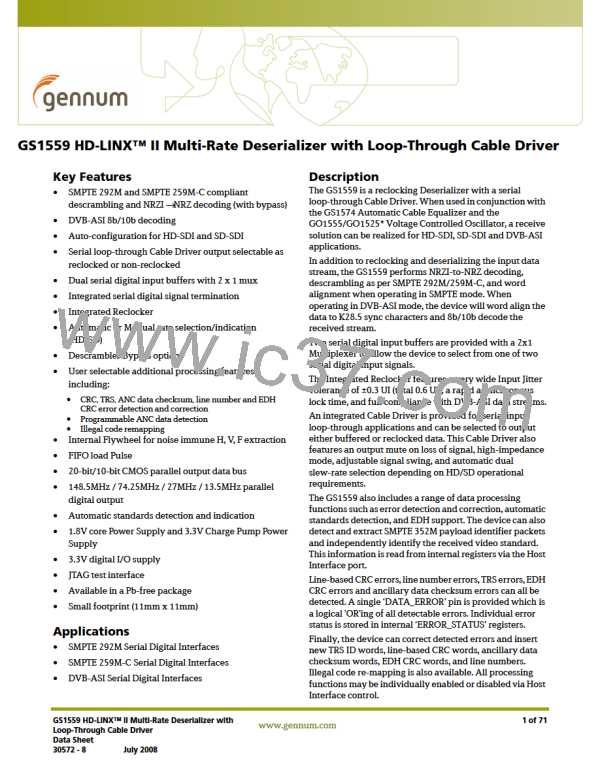The Lock Detect block may also drop out of SMPTE mode under the following
conditions:
•
•
•
•
RESET_TRST is asserted LOW
CDx is HIGH
SMPTE_BYPASS is asserted LOW in Slave mode
DVB_ASI is asserted HIGH in Slave mode
TRS word detection is a continuous process and both 8-bit and 10-bit TRS words will be
identified by the device in both SD and HD modes.
In Master mode, the GS1559 sets the SMPTE_BYPASS pin HIGH to indicate that it has
locked to a SMPTE input data stream. When operating in Slave mode, the application
layer must assert the DVB_ASI pin LOW and the SMPTE_BYPASS pin HIGH in order to
enable SMPTE operation.
4.7.1 SMPTE Descrambling and Word Alignment
After serial-to-parallel conversion, the internal 10-bit or 20-bit data bus is fed to the
SMPTE Descramble and Word Alignment block. The function of this block is to carry out
NRZI-to-NRZ decoding, descrambling according to SMPTE 259M or 292M, and word
alignment of the data to the TRS sync words.
Word alignment occurs when two consecutive valid TRS words (SAV and EAV inclusive)
with the same bit alignment have been detected.
In normal operation, re-synchronization of the word alignment process will only take
place when two consecutive identical TRS word positions have been detected. When
automatic or manual switch line lock handling is 'actioned', (see Switch Line Lock
Handling on page 33), word alignment re-synchronization will occur on the next
received TRS code word.
4.7.2 Internal Flywheel
The GS1559 has an internal Flywheel which is used in the generation of
internal/external timing signals, in the detection and correction of certain error
conditions and in automatic video standards detection. It is only operational in SMPTE
mode.
The Flywheel consists of a number of counters and comparators operating at video pixel
and video line rates. These counters maintain information about the total line length,
active line length, total number of lines per field/frame, and total active lines per
field/frame for the received video stream.
The Flywheel 'learns' the video standard by timing the horizontal and vertical reference
information contained in the TRS ID words of the received video stream. Full
synchronization of the Flywheel to the received video standard therefore requires one
complete video frame.
Once synchronization has been achieved, the Flywheel will continue to monitor the
received TRS timing information to maintain synchronization.
GS1559 HD-LINX™ II Multi-Rate Deserializer with
Loop-Through Cable Driver
Data Sheet
32 of 71
30572 - 8
July 2008

 GENNUM [ GENNUM CORPORATION ]
GENNUM [ GENNUM CORPORATION ]